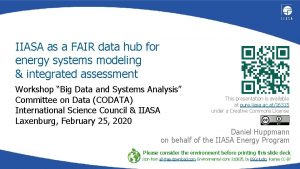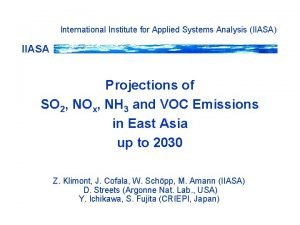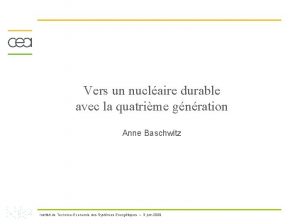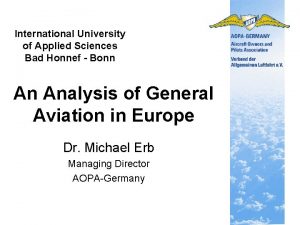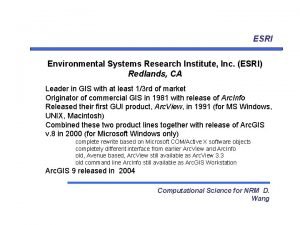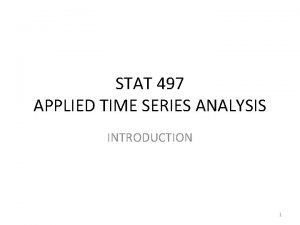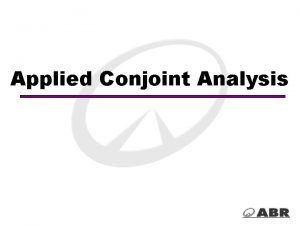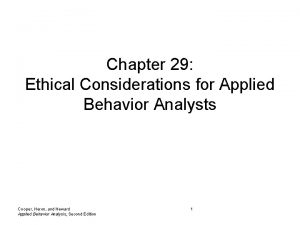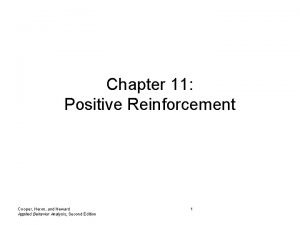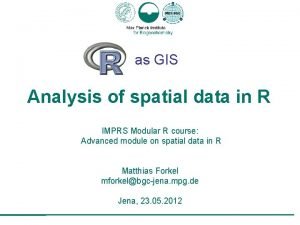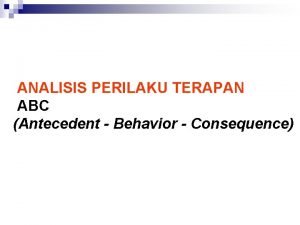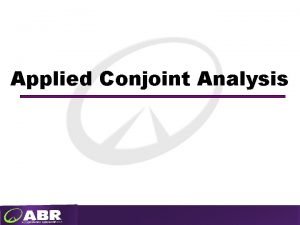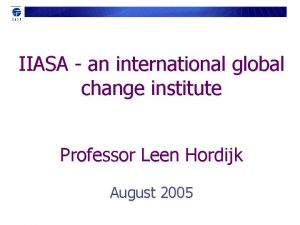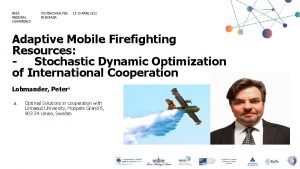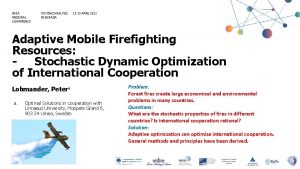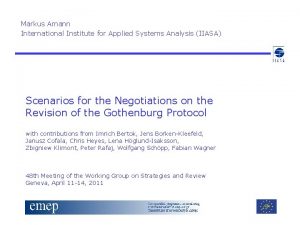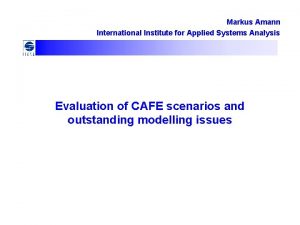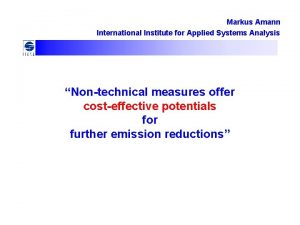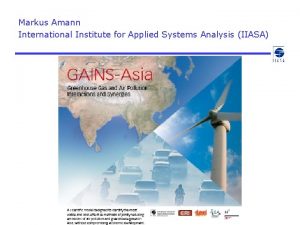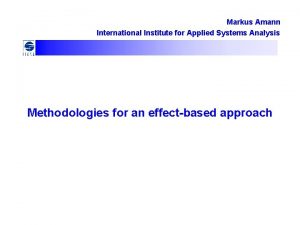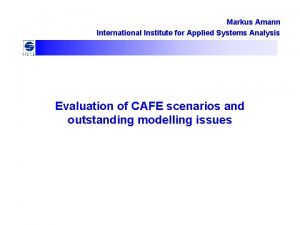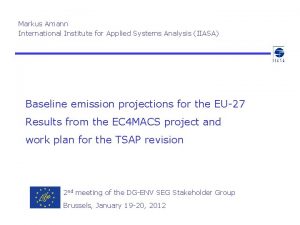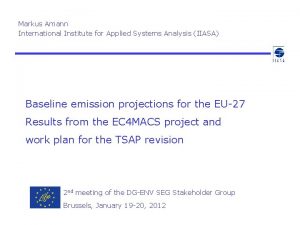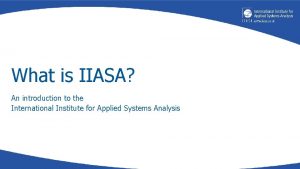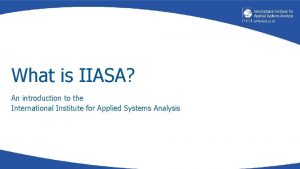International Institute for Applied Systems Analysis IIASA Mediumterm











![Global GHG emission paths A 2 and B 1 stabilization cases [Gt C/yr] A Global GHG emission paths A 2 and B 1 stabilization cases [Gt C/yr] A](https://slidetodoc.com/presentation_image_h2/a0d070881fd115b0f4e65f8c8c86dcc6/image-12.jpg)
![Main mitigation measures Cumulative carbon removal, 2000 -2100 [Gt C] 800 CO 2 CH Main mitigation measures Cumulative carbon removal, 2000 -2100 [Gt C] 800 CO 2 CH](https://slidetodoc.com/presentation_image_h2/a0d070881fd115b0f4e65f8c8c86dcc6/image-13.jpg)

















![Baseline development of European GHGs 43 countries [Mt CO 2 -eq] Based on national Baseline development of European GHGs 43 countries [Mt CO 2 -eq] Based on national](https://slidetodoc.com/presentation_image_h2/a0d070881fd115b0f4e65f8c8c86dcc6/image-31.jpg)
![Stabilization case GHG emissions by world region [Gt C-eq] A 2 Western Europe North Stabilization case GHG emissions by world region [Gt C-eq] A 2 Western Europe North](https://slidetodoc.com/presentation_image_h2/a0d070881fd115b0f4e65f8c8c86dcc6/image-32.jpg)


![Mitigation portfolio: Changes in fuel consumption, CO 2 -only case [% of baseline] Mitigation portfolio: Changes in fuel consumption, CO 2 -only case [% of baseline]](https://slidetodoc.com/presentation_image_h2/a0d070881fd115b0f4e65f8c8c86dcc6/image-35.jpg)
![Main mitigation measures Multi-gas case, Poland UK, 2020 [Mt CO 2 -eq] CO 2 Main mitigation measures Multi-gas case, Poland UK, 2020 [Mt CO 2 -eq] CO 2](https://slidetodoc.com/presentation_image_h2/a0d070881fd115b0f4e65f8c8c86dcc6/image-36.jpg)
![Marginal costs for the 15% GHG cut [€/t CO 2 -eq] CO 2 only Marginal costs for the 15% GHG cut [€/t CO 2 -eq] CO 2 only](https://slidetodoc.com/presentation_image_h2/a0d070881fd115b0f4e65f8c8c86dcc6/image-37.jpg)





![Changes in fuel consumption for the CO 2 -only case [% of baseline consumption] Changes in fuel consumption for the CO 2 -only case [% of baseline consumption]](https://slidetodoc.com/presentation_image_h2/a0d070881fd115b0f4e65f8c8c86dcc6/image-43.jpg)



![Costs for the 15% CO 2 reduction compared to REF [billion €/yr] EU-25 GHG Costs for the 15% CO 2 reduction compared to REF [billion €/yr] EU-25 GHG](https://slidetodoc.com/presentation_image_h2/a0d070881fd115b0f4e65f8c8c86dcc6/image-47.jpg)


![Costs for the 15% multi-gas reduction compared to REF [billion €/yr, % GDP 2020] Costs for the 15% multi-gas reduction compared to REF [billion €/yr, % GDP 2020]](https://slidetodoc.com/presentation_image_h2/a0d070881fd115b0f4e65f8c8c86dcc6/image-50.jpg)








![Global emission projections CH 4 and CO [Mt/yr] CH 4 CO Europe Asia + Global emission projections CH 4 and CO [Mt/yr] CH 4 CO Europe Asia +](https://slidetodoc.com/presentation_image_h2/a0d070881fd115b0f4e65f8c8c86dcc6/image-59.jpg)
![Global emission projection NOx [Mt/yr] NOx Source: M. Walsh, 2002 Europe Asia + Oceania Global emission projection NOx [Mt/yr] NOx Source: M. Walsh, 2002 Europe Asia + Oceania](https://slidetodoc.com/presentation_image_h2/a0d070881fd115b0f4e65f8c8c86dcc6/image-60.jpg)


![Change in global mean radiative forcing 2000 -2030 [W/m 2] 0. 5 0. 4 Change in global mean radiative forcing 2000 -2030 [W/m 2] 0. 5 0. 4](https://slidetodoc.com/presentation_image_h2/a0d070881fd115b0f4e65f8c8c86dcc6/image-63.jpg)

- Slides: 64

International Institute for Applied Systems Analysis (IIASA) Medium-term Mitigation for Long-term Stabilization National mitigation potentials, costs and co-benefits Side event at the Conference of the Parties (COP 10) December 8, 2004 18. 00 – 20. 00

IIASA’s research questions • How do mitigation portfolios across gases and sectors vary as a function of – different stabilization levels, – socio-economic development paths, – technology availability and costs, – policy instruments, and – degree of cooperative behavior of agents? • What are, for different policy objectives, efficient sets of medium-term mitigation options – for different global long-term strategies, – for different countries, – while maximizing co-benefits with other policy areas?

Agenda • Global long-term strategies for stabilizing GHG concentrations Nebosja Nakicenovic/Markus Amann • Medium-term potentials and costs of national GHG mitigation options - Fabian Wagner • Medium-term multi-gas mitigation strategies – Ger Klaassen • Co-benefits of greenhouse gas mitigation on air pollution – Markus Amann • The impacts of ozone precursor emissions on radiative forcing and background ozone – Frank Raes (JRC Ispra)


Nebosja Nakicenovic Keywan Riahi, Shilpa Rao Global long-term strategies for stabilizing greenhouse gas concentrations

Approach • IIASA’s MESSAGE energy model extended to other GHG emitting sectors (agriculture and forestry including C sinks) • Multi-gas (CO 2, CH 4, N 2 O, HFC, CF 4, SF 6) + black carbon • Bottom-up representation of mitigation technologies • Endogenized competition of mitigation options across all sectors • Endogenized energy feedback effects from non-CO 2 mitigation (capture of CH 4 in coal mines, CH 4 from landfills, etc. ) • Global, 11 world regions, up to 2100 • Output: Costs, main mitigation measures, uncertainties

The “fossil fuel intensive” path A 2 SRES assumptions • High population (12 bn) • Low per-capita income • Fossil fuel intensive development • Fragmented world – Emphasis on regional cultures, traditions, cooperation and economic development unions – Little technology transfer to developing countries • Large regional disparities – Ratio of North-South income gap 4: 1 in PPP (as today) – Very little further convergence

The “sustainable development” path B 1 SRES assumptions • Rapid global economic development, high per-capita income – Fast economic "catch-up" of developing countries – North-South income gap reduced to less than 2: 1 (PPP) • Rapid structural change of the global economy – “Dematerialization" of the economies – Reduced energy intensity • Changed life styles – Invoked by increased environmental awareness

Global GHG emission paths SRES A 2 and B 1”no climate measures” scenarios [Gt C/yr] A 2 Fossil fuel intensive Forestry Agriculture Mitigation in Industry & others B 1 Sustainable development Energy Sinks Mitigation in agriculture Industry & Others Mitigation in energy

The “sustainable development” path B 1 Assumed non-climate policies (according to SRES) • Globalization with enhanced multi-lateral cooperation – Technology transfer with fast introduction of advanced technologies also in developing countries – Successful large-scale R&D programs • Targeted population policies to reduce fertility rates in developing countries – World population ~6 billion • Other “sustainable development” policies – Aggressive air pollution control – Stringent efficiency standards

Illustrative stabilization analysis for the A 2 and B 1 paths Illustrative GHG stabilization target: • 4. 5 W/m 2 radiative forcing (2. 3 degrees C) increase in 2100 compared to pre-industrial levels • To be achieved through control of all 6 Kyoto gases Provisional analysis uses 100 years GWPs
![Global GHG emission paths A 2 and B 1 stabilization cases Gt Cyr A Global GHG emission paths A 2 and B 1 stabilization cases [Gt C/yr] A](https://slidetodoc.com/presentation_image_h2/a0d070881fd115b0f4e65f8c8c86dcc6/image-12.jpg)
Global GHG emission paths A 2 and B 1 stabilization cases [Gt C/yr] A 2 Fossil fuel intensive Forestry Agriculture Mitigation in Industry & others B 1 Sustainable development Energy C sinks Mitigation in agriculture Industry & others Mitigation in energy
![Main mitigation measures Cumulative carbon removal 2000 2100 Gt C 800 CO 2 CH Main mitigation measures Cumulative carbon removal, 2000 -2100 [Gt C] 800 CO 2 CH](https://slidetodoc.com/presentation_image_h2/a0d070881fd115b0f4e65f8c8c86dcc6/image-13.jpg)
Main mitigation measures Cumulative carbon removal, 2000 -2100 [Gt C] 800 CO 2 CH 4 N 2 O

Co-benefits of GHG stabilization on emissions of black carbon and organic carbon, A 2 scenario [Mt] Black carbon Organic carbon Emission reductions from stabilization in: Stabilization case Power generation Industry Residential Transport

Conclusions • Sustainable development paths achieve a significant share of stabilization effort as a co-benefit • In fossil-intensive paths stabilization efforts are very costly • Non-CO 2 mitigation options reduce stabilization costs • Mitigation of non-CO 2 gases make an important contribution in the near-term, but CO 2 mitigation remains essential in the long-term • GHG stabilization paths lead to a significant reduction of black and organic carbon as a co-benefit


Fabian Wagner Lena Hoglund, Ger Klaassen, Antti Tohka, Wilfried Winiwarter Medium-term potentials and costs of national greenhouse gas mitigation options

GAINS A new tool to analyze synergies between air pollution and GHGs • GAINS: GHG-Air pollution INteractions and Synergies • Extension of RAINS integrated assessment model for air pollution to GHGs • CO 2, CH 4, N 2 O, HFC, PFC, SF 6 in addition to SO 2, NOx, VOC, NH 3, PM • Country-by-country, 43 regions in Europe, up to 2030

Methodology For all anthropogenic sources of GHG emissions in a country: • Identification of available mitigation options – Including structural changes (fuel switch) and add-on measures • Country-specific application potentials – Baseline activity rates: national projections – Substitution potential derived from national energy models • Quantification of societal resource costs – Excluding transfers (profits, taxes, etc. ) • Data sources – GHG emission inventories consistent with UNFCCC – GHG technology cost data from reviewed literature – Activity projections: provided by national governments and EU Commission

Main mitigation options for CO 2 162 options considered in GAINS • Power plants – Fuels shift to natural gas and renewables – Co-generation – Carbon capture • Transport – More efficient vehicles (hybrid cars) – Alternative fuels (ethanol, gas, biodiesel, hydrogen) • Industry – End-use savings – Fuel shifts • Domestic – Insulation – Solar, biomass – Fuel shift to natural gas

National cost curves for CO 2 Marginal costs for national energy projections 2020 [€/t CO 2]

Main mitigation options for CH 4 28 options considered in GAINS • Gas sector – Reduced leakages during gas transmission and distribution – Flaring instead of venting • Waste management – Recycling/composting of biodegradable waste instead of landfill – Methane recovery from landfills • Enteric fermentation – Dietary changes for cattle coupled with livestock reductions • Manure management – Anaerobic digestion plants and stable adaptation • Coal mines – Upgraded gas recovery in coal mines • Rice paddies – Modified rice strains

National cost curves for CH 4 Marginal costs for national activity projections 2020 [€/t CO 2 -eq] Costs for additional reductions beyond current legislation

Main mitigation options for N 2 O 18 options considered in GAINS • Arable land grassland – – – Reduced fertilizer application Optimal timing of fertilizer application Nitrification inhibitors Precision farming Less use of histosols (peat soils) • Industry – Emission controls in adipic acid and nitric acid industry • Combustion – Modified fluidized bed combustion • Health care – Reduced N 2 O use • Waste treatment – Optimized waste water treatment

National cost curves for N 2 O Marginal costs for national activity projections 2020 [€/t CO 2 -eq]

Main mitigation options for F-gases 22 options considered in GAINS • Refrigeration (domestic, commercial, transport and industrial) – Recollection, alternative refrigerants and good practice • Mobile and stationary air conditioning – Alternative refrigerants, process modifications, good practice • HCFC 22 production – Incineration • Primary aluminum production – Conversion to other processes • Semiconductor industry – Limited PFC use through alternative processes • Other sectors – – SO 2 cover for magnesium production Good practice for gas insulated switchgears Alternative propellants for foams and aerosols End of life recollection of SF 6

Conclusions • GAINS offers a tool for assessing national abatement costs and potentials for reducing the 6 Kyoto gases • Based on national projections of economic activities • More than 220 mitigation options considered • Currently implemented for 43 regions in Europe Implementation for Asia in progress • Large differences in mitigation potentials and costs across regions and gases


Ger Klaassen Markus Amann, Lena Höglund, Fabian Wagner, Wilfried Winiwarter Medium-term multi-gas mitigation strategies

Approach • Starting point: – National projections of economic activities (energy use, agriculture, industrial production, etc. ) – For groups of countries (e. g. , world regions of global model, etc. ) – For medium-term time horizon (e. g. , 2020) • Compare implied GHG projections with regional results of global stabilization analyses • Derive GHG emission targets consistent with global analysis • Explore medium-term mitigation portfolios that meet these targets, starting from the national activity projections – Mitigation costs – Distributional aspects • Return emissions and carbon prices to global analysis
![Baseline development of European GHGs 43 countries Mt CO 2 eq Based on national Baseline development of European GHGs 43 countries [Mt CO 2 -eq] Based on national](https://slidetodoc.com/presentation_image_h2/a0d070881fd115b0f4e65f8c8c86dcc6/image-31.jpg)
Baseline development of European GHGs 43 countries [Mt CO 2 -eq] Based on national projections of activity data: 1990 2020 Change relative to 1990 CO 2 6482 6390 -1% CH 4 1476 1206 -19% N 2 O 741 594 -20% SUM 8699 8190 -6%
![Stabilization case GHG emissions by world region Gt Ceq A 2 Western Europe North Stabilization case GHG emissions by world region [Gt C-eq] A 2 Western Europe North](https://slidetodoc.com/presentation_image_h2/a0d070881fd115b0f4e65f8c8c86dcc6/image-32.jpg)
Stabilization case GHG emissions by world region [Gt C-eq] A 2 Western Europe North America South Asia Middle East B 1 Central and Eastern Europe Latin America Centrally planned Asia Africa Former Soviet Union Pacific Asia Pacific and Oceania Europe

Illustrative example Apply GAINS to explore least-cost mitigation strategies • For the national baseline projections for 43 European regions for 2020: • Explore a further 15% cut in total GHG emissions beyond current legislation: 1. With CO 2 measures only 2. Methane case: With CO 2 and CH 4 measures 3. Multi-gas case: With CO 2, CH 4 and N 2 O measures

Emission reductions and costs for the 15% GHG cut in 2020 GHG reductions [Mt CO 2 -eq] Mitigation costs [billion €/year]
![Mitigation portfolio Changes in fuel consumption CO 2 only case of baseline Mitigation portfolio: Changes in fuel consumption, CO 2 -only case [% of baseline]](https://slidetodoc.com/presentation_image_h2/a0d070881fd115b0f4e65f8c8c86dcc6/image-35.jpg)
Mitigation portfolio: Changes in fuel consumption, CO 2 -only case [% of baseline]
![Main mitigation measures Multigas case Poland UK 2020 Mt CO 2 eq CO 2 Main mitigation measures Multi-gas case, Poland UK, 2020 [Mt CO 2 -eq] CO 2](https://slidetodoc.com/presentation_image_h2/a0d070881fd115b0f4e65f8c8c86dcc6/image-36.jpg)
Main mitigation measures Multi-gas case, Poland UK, 2020 [Mt CO 2 -eq] CO 2 CH 4 N 2 O *) not yet included in GAINS
![Marginal costs for the 15 GHG cut t CO 2 eq CO 2 only Marginal costs for the 15% GHG cut [€/t CO 2 -eq] CO 2 only](https://slidetodoc.com/presentation_image_h2/a0d070881fd115b0f4e65f8c8c86dcc6/image-37.jpg)
Marginal costs for the 15% GHG cut [€/t CO 2 -eq] CO 2 only case CO 2+CH 4 case Multi-gas case CO 2 90 40 38 CH 4 - 40 38 N 2 O - - 38

Conclusions • GAINS offers a practical tool for exploring national mediumterm mitigation portfolios consistent with long-term stabilization targets • Not policy-prescriptive, but to explore implications of alternative stabilization strategies on individual countries • Inclusion of non-CO 2 GHGs in mitigation strategies creates economic flexibility to improve cost-effectiveness: – For a 15% reduction of European GHG emissions in 2020: – Costs drop from 0. 18% of GDP for a CO 2 -only strategy to 0. 04 % for a multi-gas approach


Markus Amann J. Cofala, Z. Klimont, L. Höglund, F. Wagner, W. Winiwarter Co-benefits of greenhouse gas mitigation on air pollution

Background • Greenhouse gases and air pollutants originate from the same sources • New scientific findings on role of aerosols and ground -level ozone for radiative forcing and air pollution • Initial GAINS focus on economic synergies: Simultaneous emission reductions offer co-benefits • Explore differences between developing and industrialized countries

Approach • GAINS cost curves for GHGs combined with RAINS cost curves for air pollutants • Illustrative GAINS analysis for the GHG scenarios presented before • Starting point: National activity projections for 2020 • Case 1: CO 2 -only case – 15% GHG reduction with CO 2 only – Implied carbon price: 90 €/t CO 2
![Changes in fuel consumption for the CO 2 only case of baseline consumption Changes in fuel consumption for the CO 2 -only case [% of baseline consumption]](https://slidetodoc.com/presentation_image_h2/a0d070881fd115b0f4e65f8c8c86dcc6/image-43.jpg)
Changes in fuel consumption for the CO 2 -only case [% of baseline consumption]

Change in emissions and AQ impacts accompanying the CO 2 reduction, compared to the baseline 2020

Avoided premature deaths attributable to PM 2. 5 accompanying the CO 2 reduction of EU-25 [cases/yr] 1000 0 -1000 -2000 -3000 -4000 Provisional GAINS calculations

Change in emissions and health impacts accompanying the CO 2 reduction, compared to the baseline 2020
![Costs for the 15 CO 2 reduction compared to REF billion yr EU25 GHG Costs for the 15% CO 2 reduction compared to REF [billion €/yr] EU-25 GHG](https://slidetodoc.com/presentation_image_h2/a0d070881fd115b0f4e65f8c8c86dcc6/image-47.jpg)
Costs for the 15% CO 2 reduction compared to REF [billion €/yr] EU-25 GHG mitigation costs CO 2 Avoided costs for air pollution control SO 2 -2. 0 NOx -2. 9 PM -1. 1 Total Net mitigation costs Health benefits Turkey +23. 6 +2. 2 -6. 0 0 +17. 6 +2. 2 -3. 0 -8. 0

The multi-gas case • 15% reduction in GHGs • Achieved by CO 2, CH 4 and N 2 O • Carbon price: ~40 €/t CO 2

Change in emissions and health impacts accompanying the GHG reduction, compared to the baseline 2020
![Costs for the 15 multigas reduction compared to REF billion yr GDP 2020 Costs for the 15% multi-gas reduction compared to REF [billion €/yr, % GDP 2020]](https://slidetodoc.com/presentation_image_h2/a0d070881fd115b0f4e65f8c8c86dcc6/image-50.jpg)
Costs for the 15% multi-gas reduction compared to REF [billion €/yr, % GDP 2020] EU-25 GHG mitigation GHG costs CO 22 CO CO 2 CH 44 CH CH 4 N 22 O O NN O 2 +5. 7 +0. 4 Total Avoided costs Avoided for air pollution for control Net mitigation Net costs Health benefits Turkey +0. 6 -0. 1 00 +6. 8 SO SO 222 NO NOxxx -1. 6 -1. 4 PM PM Total -0. 7 0. 04% +0. 5 0. 12% +0. 5 0. 02% +0. 5 0. 12% -2. 3 -0. 016% -4. 0 -0. 90% -3. 7 +3. 1

A bio-fuel case Increased biomass use in households: 10% of light fuel oil is replaced by biomass (wood), burned in most advanced boilers CO 2 -17 Mt SO 2 - 2 kt NOx +1 kt PM 2. 5 +25 kt ~ 0. 5% of EU 2000 emission ~ Finland’s 2000 emissions

Differences in premature deaths attributable to PM 2. 5, compared to REF (cases/year) Fuel-shift case +1000 0 -1000 -2000 -3000 -4000 Bio-fuel case

Conclusions • Co-benefits of GHG reductions on air pollution are substantial – Fuel shifts for CO 2 reductions can save 1000 s of lives – But GHG mitigation relying on bio-fuels can deteriorate air pollution, especially in developing countries • In situations with stringent air pollution controls, CO 2 reductions can avoid significant costs for air pollution controls. Cost savings occur immediately to the same sectors. • Multi-gas GHG strategies have less CO 2 co-benefits, but better cost-effectiveness ratio. Co-benefits on ozone! • The GAINS model offers a tool for quantitative analysis


Frank Raes, Frank Dentener IES, Joint Research Centre of the European Commission, Ispra, Italy The impacts of ozone precursor emissions on radiative forcing and background ozone

Methane and tropospheric ozone SOME FACTS • CH 4 is emitted into the atmosphere and is removed by oxidation into CO and CO 2 • O 3 is produced in the atmosphere from precursor gases like CH 4, NMVOC, NOX • CH 4 and CO contribute to hemispheric background O 3 (~35 ppb) • Recent studies find O 3 health effects at current background levels • CH 4 produces the 2 nd largest radiative forcing • O 3 produces the 3 rd largest radiative forcing

Tropospheric ozone and methane QUESTIONS ADRESSED • CH 4 emission controls aim at reducing radiative forcing. What is their potential for reducing background O 3? – Effect of CC policy on conventional AQ • NOx and NMVOC emisison controls aim at reducing O 3. What is their potential for reducing radiative forcing? – Effect of AQ policy on CC

Approach Global emission projections up to 2030 with GAINS model • For CH 4, CO, NOx, NMVOC • Four scenarios – – • Compute impact of scenario’s on – – – • “Current legislation”: baseline “Maximum feasible” NOx and NMVOC reductions (AQ) “Maximum feasible” CH 4 reduction (CC) “Maximum feasible” CH 4, NOx and NMVOC reductions (combined) Background tropospheric ozone concentrations Methane concentrations Radiative forcing by O 3 aand CH 4 With – – TM 3 (JRC Ispra) STOCHEM (UK Met. Office)
![Global emission projections CH 4 and CO Mtyr CH 4 CO Europe Asia Global emission projections CH 4 and CO [Mt/yr] CH 4 CO Europe Asia +](https://slidetodoc.com/presentation_image_h2/a0d070881fd115b0f4e65f8c8c86dcc6/image-59.jpg)
Global emission projections CH 4 and CO [Mt/yr] CH 4 CO Europe Asia + Oceania Africa + Middle East SRES A 2 - World Total North America Latin America Maximum Feasible Reduction (MFR) SRES B 2 - World Total
![Global emission projection NOx Mtyr NOx Source M Walsh 2002 Europe Asia Oceania Global emission projection NOx [Mt/yr] NOx Source: M. Walsh, 2002 Europe Asia + Oceania](https://slidetodoc.com/presentation_image_h2/a0d070881fd115b0f4e65f8c8c86dcc6/image-60.jpg)
Global emission projection NOx [Mt/yr] NOx Source: M. Walsh, 2002 Europe Asia + Oceania Africa + Middle East North America Latin America Maximum Feasible Reduction (MFR)

Impacts of CH 4 and NOx/VOC controls on ozone and CH 4 burden Global emission scenarios: ___ Baseline ___ Max CH 4 reduction ___ Max NOx+NMVOC reduction ___ Max CH 4+NOx+NMVOC reduction Global emission scenarios developed by IIASA/RAINS, TM 3 calculations by JRC-IES

Changes in background ozone between baseline 2020 and MFR of CH 4+NOx+NMVOC O 3 (ppb) Global emission scenarios developed by IIASA/RAINS, TM 3 calculations by JRC-IES
![Change in global mean radiative forcing 2000 2030 Wm 2 0 5 0 4 Change in global mean radiative forcing 2000 -2030 [W/m 2] 0. 5 0. 4](https://slidetodoc.com/presentation_image_h2/a0d070881fd115b0f4e65f8c8c86dcc6/image-63.jpg)
Change in global mean radiative forcing 2000 -2030 [W/m 2] 0. 5 0. 4 0. 3 0. 2 0. 1 CH 4 + O 3 -0. 2 O 3 -0. 1 CH 4 0 Baseline MFR CH 4 MFR NOx+NMVOC MFR CH 4+NOx+NMVOC Radiative forcing from CH 4 O 3 Total CH 4+O 3 The red error bars indicate the uncertainty ranges identified in IPCC TAR

Conclusions • Ozone precursor emissions influence background ozone and radiative forcing • Baseline scenario (CLE) leads to an increase in both hemispheric ozone (+5 ppb) and O 3+CH 4 radiative forcing (+0. 2 W/m 2) in next 30 years • NOx and NMVOC controls would decrease ozone, but increase the lifetime of methane: effects on radiative forcing cancel out • Max CH 4, NOx and NMVOC controls would reduce both hemispheric ozone (- 9 ppb) and O 3+CH 4 radiative forcing ( 0. 3 W/m 2) compared to the baseline.
 International institute for applied system analysis
International institute for applied system analysis Iiasa scenario explorer
Iiasa scenario explorer Iiasa
Iiasa Iiasa
Iiasa Iiasa membership
Iiasa membership Vocational education uae
Vocational education uae Keldysh institute of applied mathematics
Keldysh institute of applied mathematics Applied prevention science international
Applied prevention science international International university of applied sciences bad honnef
International university of applied sciences bad honnef Iupap
Iupap Applied educational systems
Applied educational systems Applied systems inc subsidiaries
Applied systems inc subsidiaries Oikos
Oikos International institute of christian discipleship
International institute of christian discipleship Gimi israel
Gimi israel International institute of health management research
International institute of health management research Excellentia international institute
Excellentia international institute International institute of christian discipleship
International institute of christian discipleship Aerospace vehicle systems institute
Aerospace vehicle systems institute Environmental systems research institute inc.
Environmental systems research institute inc. Environmental systems research institute
Environmental systems research institute Institute for software integrated systems
Institute for software integrated systems Applied time series analysis pdf
Applied time series analysis pdf Conditioned motivating operations
Conditioned motivating operations Applied conjoint analysis
Applied conjoint analysis Ethical issues in applied behavior analysis
Ethical issues in applied behavior analysis Stimulus definition
Stimulus definition Business management courses winnipeg
Business management courses winnipeg R for gis
R for gis Teori perilaku abc
Teori perilaku abc Discourse analysis in applied linguistics
Discourse analysis in applied linguistics Applied conjoint analysis
Applied conjoint analysis Iso 22301 utbildning
Iso 22301 utbildning Typiska novell drag
Typiska novell drag Nationell inriktning för artificiell intelligens
Nationell inriktning för artificiell intelligens Returpilarna
Returpilarna Varför kallas perioden 1918-1939 för mellankrigstiden
Varför kallas perioden 1918-1939 för mellankrigstiden En lathund för arbete med kontinuitetshantering
En lathund för arbete med kontinuitetshantering Särskild löneskatt för pensionskostnader
Särskild löneskatt för pensionskostnader Vilotidsbok
Vilotidsbok Anatomi organ reproduksi
Anatomi organ reproduksi Vad är densitet
Vad är densitet Datorkunskap för nybörjare
Datorkunskap för nybörjare Boverket ka
Boverket ka Hur skriver man en debattartikel
Hur skriver man en debattartikel Delegerande ledarstil
Delegerande ledarstil Nyckelkompetenser för livslångt lärande
Nyckelkompetenser för livslångt lärande Påbyggnader för flakfordon
Påbyggnader för flakfordon Vätsketryck formel
Vätsketryck formel Offentlig förvaltning
Offentlig förvaltning Jag har nigit för nymånens skära
Jag har nigit för nymånens skära Presentera för publik crossboss
Presentera för publik crossboss Jiddisch
Jiddisch Bat mitza
Bat mitza Treserva lathund
Treserva lathund Mjälthilus
Mjälthilus Claes martinsson
Claes martinsson Cks
Cks Programskede byggprocessen
Programskede byggprocessen Mat för unga idrottare
Mat för unga idrottare Verktyg för automatisering av utbetalningar
Verktyg för automatisering av utbetalningar Rutin för avvikelsehantering
Rutin för avvikelsehantering Smärtskolan kunskap för livet
Smärtskolan kunskap för livet Ministerstyre för och nackdelar
Ministerstyre för och nackdelar Tack för att ni har lyssnat
Tack för att ni har lyssnat

